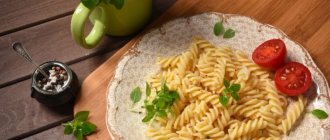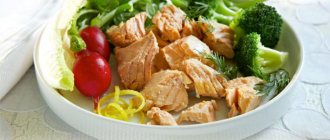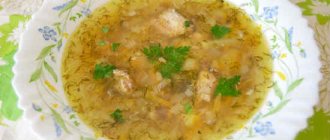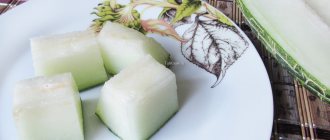Haddocks are marine ray-finned fish belonging to the cod family. Representatives of this taxonomic group live in the waters of the Arctic and Atlantic oceans. Haddocks prefer to stay in the water column or near the bottom, forming large aggregations. Therefore, they are caught using gill nets, longlines, mid-water and bottom trawls. Norway and Great Britain are considered the leaders among suppliers of this fish to the international market.
Haddock is sold frozen, chilled, dried, salted or smoked. The elastic, dietary meat of this fish is suitable for any cooking method. It is boiled in water and steamed, baked on the grill or in the oven, fried in a small amount of oil, and stewed. In addition, it is used to prepare fish cutlets, soup and fillings for various types of baked goods.
Nutritional value and calorie content of haddock
One hundred grams of raw product contains 16.32 g of protein and 0.45 g of fat, as well as 11 mg of calcium, 0.17 mg of iron, 21 mg of magnesium, 227 mg of phosphorus, 286 mg of potassium, 213 mg of sodium, 0.32 mg of zinc , 0.021 mg copper, 0.011 mg manganese, 25.9 mcg selenium.
In addition, the fish pulp contains tryptophan (0.212 g), isoleucine (0.871 g), threonine (0.829 g), lysine (1.736 g), leucine (1.537 g), cystine (0.203 g), methionine (0.56 g ), phenylalanine (0.738 g), valine (0.974 g), histidine (0.557 g), arginine (1.131 g). The fish also contains aspartic acid (1.936 g), glutamic acid (2.822 g), serine (0.771 g) and alanine (1.143 g).
The caloric content of haddock is much lower than that of other members of the cod family.
Calorie content of haddock is 74 kcal per 100 g of raw fish.
How many calories are in different types of fried fish?
Also, to decide the question of how many calories are in fried fish, it is worth considering the specific recipe. Basically, the product is prepared in oil, which is absorbed very well, especially into soft fillets of pollock, pangasius, and haddock. How many calories the fish will gain depends on the volume and type of oil. Creamy is a little lighter - 771 kcal per 100 g, but vegetable has more than 800 kcal, so you should be careful with it.
If you want dietary fried fish, cook it in a dry grill pan or only lightly grease the bottom with oil: do not let the product float in fat.
Various additives also significantly add calories to fried fish: breading in flour or breadcrumbs is even more so than egg-milk batter. And if you sprinkle the product with cheese when frying, not only the number of calories will increase, but also the volume of fat. Approximate calorie values for different types of fish fried without additives in vegetable oil:
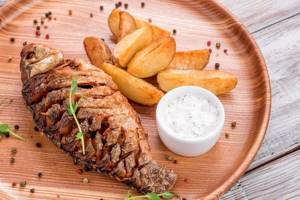
- Pollock – 137 kcal.
- Crucian carp – 121 kcal.
- Carp – 197 kcal.
- Pike – 127 kcal.
- Flounder – 91 kcal.
- Cod – 60 kcal.
The approximate calorie content of fried fish without additives ranges from 60-200 kcal, depending on the type of product. If you prepare the product by rolling it in flour, the indicator will increase by 30-50 kcal: the figure is determined by the amount of breading.
Useful properties of haddock
The beneficial properties of haddock are identical to those of cod pulp.
The beneficial properties of haddock for the human body are due to the content of particularly nutritious and healthy fat. The fat of this fish accumulates in the liver. It contains iodine, phosphorus, essential amino acids, polyunsaturated fatty acids from the Omega-3 series - eicosapentaenoic and alpha-linolenic, as well as vitamins A and D. Regular consumption of fish oil ensures the full functioning of the brain and eyes, helps lower the concentration of cholesterol in the blood plasma, and also speeds up the healing process for various diseases. That is why haddock fat is often included in various medications.
One hundred grams of fish contains 44% of the daily dose of selenium, which plays an important role in the processes of absorption of carbohydrates and fats in the human body.
Its pulp contains a lot of protein - the main building material and a necessary component for the production of immune antibodies.
Haddock pulp is very easily and quickly digested in the digestive tract, since it does not contain elastin (insoluble protein). The pulp is ideal for dietary nutrition.
Eating fish has a beneficial effect on the condition of the skin, hair, nails and all mucous membranes of the body. It is especially useful to include it in the menu during pregnancy.
Nutritional value
If you are looking for fish with a rich nutritional composition, haddock will satisfy your needs. Its fillet is the perfect combination of a large amount of protein and a small portion of fat. 100 grams of fresh fillet contains 76 kcal, 17.5 grams of protein and less than 1 gram of fat (the rest of the fat is concentrated in the liver of the fish, which can sometimes make up almost half of the total weight of haddock). In addition, this fish contains carbohydrates, vitamins, and minerals in proportions necessary to maintain the healthy functioning of the body. Haddock is rich in substances that are extremely important for humans, which our bodies are not able to produce on their own.
As already mentioned, haddock is rich in vitamins, which affect the condition of the entire body. Thus, vitamin A plays a role in protecting against free radicals and preventing eye diseases. B vitamins regenerate cells and tissues and are responsible for healthy hair and skin. It is extremely important that the group of B vitamins in this fish is also represented by the B12 component, which is present exclusively in products of animal origin, but is indispensable for humans. This vitamin is important for the proper functioning of the nervous system and healthy brain function. Sufficient consumption of B12 is the key to the absence of anemia. And vitamin D, also found in fish, will help maintain the strength of bones and teeth.
The mineral composition of haddock fillet is no less rich. In this product, scientists found sodium - good for muscles, phosphorus - important for the proper functioning of the kidneys, magnesium and calcium, which have a beneficial effect on the condition of bone tissue, and selenium - a powerful antioxidant that prevents cell mutations.
Protein from fish is a source of essential amino acids that our body is not able to produce on its own, but without which it cannot function properly. should be ingested with food rich in proteins. These substances affect the growth and development of muscle tissue and accelerate metabolism. And one more interesting note: the proteins contained in haddock fillets are more easily absorbed by the body than proteins from meat.
Nutritional value per 100 g
| 76 kcal |
| 17.5 g |
| 0.6 g |
| 0 g |
| 57 IU |
| 0.4 mg |
| 23 IU |
| 3.8 mg |
| 0.3 mg |
| 12 IU |
| 1.2 mg |
| 260 mg |
| 311 mg |
| 22 mg |
| 188 mg |
| 39 mg |
| 1.1 mg |
| 0.4 mg |
Methods for preparing haddock
Haddock pulp is suitable for preparing a large number of delicious dishes. Its delicate and mild taste goes well with various vegetables and spices, as well as hot and sweet and sour sauces. From elastic fish fillets you can make dumplings, pies, fish cakes, soufflés, and casseroles.

This fish can be fried, boiled, smoked, salted, or steamed. It is best to fry haddock in a ceramic frying pan without adding oil.
Dense and large fish scales should best be removed along with the skin.
Bake for the benefit of the stomach and without harm to the body
The baked haddock looks very beautiful. Its calorie content can vary from 75 to 190 kilocalories per 100 grams, depending on the chosen marinade and added oil. Your family will certainly appreciate the original recipe for cooking fish with beets. It may sound bland, but the taste is very, very interesting.
So, fish fillets need to be cut into portions, dried with paper towels, and then salt and pepper. Spices should be added to taste. For the marinade, you can use lemon juice, garlic or onions. Grease the mold with oil and place onion cut into half rings and thin slices of boiled beets on the bottom. For juiciness, pour low-fat sour cream over the layer of vegetables. Place the fish on top and again pour the sauce of sour cream, garlic and spices over everything.
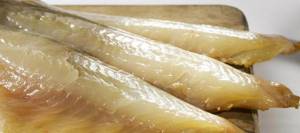
Haddock storage conditions
Haddock, fresh or chilled, spoils very quickly. Therefore, the fish should be placed in a special container and stored in the refrigerator for no more than two days at a temperature of -18°C and below.
This fish can be stored in the freezer for six months. Before freezing, the haddock should be divided into portions.
Video from YouTube on the topic of the article:
Found an error in the text? Select it and press Ctrl + Enter.
Four pieces of dark chocolate contain about two hundred calories. So if you don’t want to gain weight, it’s better not to eat more than two slices a day.
People who eat breakfast regularly are much less likely to be obese.
Tooth decay is the most common infectious disease in the world, which even the flu cannot compete with.
The human brain weighs about 2% of the total body weight, but it consumes about 20% of the oxygen entering the blood. This fact makes the human brain extremely susceptible to damage caused by a lack of oxygen.
The highest body temperature was recorded in Willie Jones (USA), who was admitted to the hospital with a temperature of 46.5°C.
If your liver stopped working, death would occur within 24 hours.
Most women are able to derive more pleasure from contemplating their beautiful body in the mirror than from sex. So, women, strive to be slim.
There are very interesting medical syndromes, for example, compulsive swallowing of objects. One patient suffering from this mania had 2,500 foreign objects in her stomach.
Over the course of a lifetime, the average person produces no less than two large pools of saliva.
Research shows that women who drink several glasses of beer or wine per week have an increased risk of developing breast cancer.
According to many scientists, vitamin complexes are practically useless for humans.
The average life expectancy of left-handers is shorter than that of right-handers.
It was previously believed that yawning enriches the body with oxygen. However, this opinion has been refuted. Scientists have proven that yawning cools the brain and improves its performance.
Regular use of a solarium increases your chance of developing skin cancer by 60%.
Scientists from Oxford University conducted a series of studies in which they came to the conclusion that vegetarianism can be harmful to the human brain, as it leads to a decrease in its mass. Therefore, scientists recommend not completely excluding fish and meat from your diet.
Each of us has heard stories about people who never brushed their teeth and had no problems doing so. So, most likely, these people either did not know about their presence.
When is it harmful to eat haddock?
Only in rare cases of individual intolerance. Everyone else is given the green light for culinary experiments involving haddock!
Haddock and cooking
You can prepare a lot of delicious dishes from this fish, because its magnificent elastic meat goes well with many foods and is equally appetizing in all forms - fried, boiled, salted, baked, smoked or canned. Boiled or steamed haddock will attract with its snow-white exfoliating meat, smoked or salted with its rich smell and unusual taste, and fried with its crispy golden-red crust, especially if you first breaded the haddock fillet in breadcrumbs.
Most often, we have haddock pulp on sale in fresh frozen form, but finding fresh haddock carcasses will be problematic.
It is good to cook haddock in combination with vegetables, hot or sweet and sour sauces and spices. Its meat will make wonderful fish cutlets, casseroles and pates. Haddock is an ingredient in many salads and is also used for filling pies and pies.
How to fry haddock?
There are no complications or secrets here. Simply clean the haddock carcass from scales and entrails, divide into portions, then roll each in breadcrumbs and fry.
The only advice regarding frying haddock: it is better to do without vegetable oil. To ensure that the fish is well fried and does not stick, use a ceramic frying pan.
How to bake haddock?
Baked haddock is a great addition to any side dish. And it is prepared very simply. Place pre-salted haddock meat (fillets or whole carcasses) on a greased baking sheet. Top the meat with a layer of onions (2-3 large onions) fried in vegetable oil with mushrooms (400-500 g). After this, pour everything with sauce from a mixture of liquid cream (250 ml) and sour cream (250 ml). Sprinkle generously with grated cheese on top. The haddock casserole will be ready in about 40 minutes. Before serving, do not forget to garnish with herbs.
How to select and store haddock?
It was already mentioned above that it will be quite difficult to acquire fresh haddock, because in our region it is most often delivered frozen. When purchasing, inspect the fish - its eyes should not be cloudy, the gills should not be darkened, but bright red. The haddock should have a fresh sea fish smell. The color of the meat is white, without a hint of gray or yellowness. Frozen haddock should have a minimal layer of ice, and the edges of the belly should not be dry.
Haddock is a perishable product, so the duration of its stay in the refrigerator should not exceed 2 days. But frozen haddock can be stored in the freezer for up to six months.
How to choose good fish and check its quality
The freshness of haddock and its quality are determined by visual characteristics. When frozen, the fish is of decent quality - with a minimum of ice , which unfavorably adds additional weight due to unwanted liquid and distorted shape of the fish.
The natural position of the frozen product guarantees the absence of repeated defrosting and freezing. Fish with a crooked body position have poor taste and may contain signs of meat spoilage. When choosing fresh fish, there are other selection criteria :
- Smell . The recently caught inhabitant of the depths has the aroma of the sea, it does not have the unpleasant odors of rot, dirt, or mud.
Eyes . The presence of transparent eyeballs is a confirmation of the high freshness of the haddock; cloudy ones are evidence of a long sale (the product has been stale).
Gills . The color indicator of a quality product is the light color of the gills, while a low-quality product is brown or gray.
Meat . A white tint indicates a recent catch, while yellow is a likely sign of incipient decomposition caused by long storage.
Sometimes in markets fresh cod is passed off as haddock. To prevent this from happening, it is necessary to have an idea of the external structure of this fish. The easiest way to detect a substitution is to examine its skin: cod is covered with small scales that are easily separated from the skin, while the other variant being compared is protected by a denser surface with large scales.
The absence of scales should raise suspicions about the seller’s desire to hide some flaws : in cod processing factories it is not customary to remove the protective layer. An additional disadvantage of selling skinless fillets is the inability to distinguish between the two species when cut.
“Getting to know” haddock
Before moving on to studying the health benefits of haddock meat, we suggest you discover some interesting information about this fish.
This representative of the largest family of cod fish lives mainly in the Arctic and Atlantic Oceans (or rather, in their northern seas) at depths ranging from 30 m to two hundred meters. Sometimes haddocks descend to great depths - up to 1 kilometer. You can meet schools of haddock in the seas (Norwegian, Barents), off the North American and Icelandic coasts, near the European coasts. The haddock fishery covers the northern Atlantic region.
Haddock is a fairly large fish. Its length usually reaches 50-75 cm, and its weight is 2-3 kg. Although fishermen often pulled out huge haddocks weighing up to 20 kg and a meter long from their nets.
The body of the haddock is silvery and slightly flattened on the sides. The color of the back is dark gray with a slight lilac sheen. The abdomen is milky white. A characteristic feature of haddock is a transverse black stripe stretching along the entire body in the lower back. And on both sides of the head of these fish there are dark oval marks, somewhat similar to a fingerprint.
Haddock has 3 fins on the back, and another pair is located under the belly. The upper jaw protrudes forward slightly. The growth of the fish continues for fourteen long years, and haddock eggs can be laid from the age of 5-6 years.
Composition, calorie content per 100 g, nutritional and energy value
Haddock belongs to the group of fish with moderate calorie content: 70–72 kcal per 100-gram serving . The absence of fat (less than 200 mg) makes dishes from this seafood a dietary product, and the impressive concentration of healthy protein (17.1 mg - 33% of the daily value) makes it a nutritious food at the same time.
The greatest amount of useful substances (mg per 100 g):
phosphoric acid - 3;
vitamin B2 - 0.15.
Other important substances and vitamins have lower concentrations (relative to the daily dose): iron, molybdenum, selenium, cobalt, sodium, glutamic acid, leucine, manganese, serine, histidine.
The glycemic index here is close to zero , so even after heavy consumption of this fish, there is no increase in blood sugar levels.
Despite the impressive amount of phosphorus, the representative of the deep sea does not hold a record for the content of this element: tuna and cod overtake haddock, having 260 and 203 mg of phosphorus, respectively.
How to calculate the calorie content of fried fish?
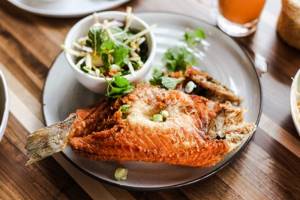
Turning to open sources for ready-made data every time is difficult. Moreover, no one will give you the exact values: they depend on your recipe. In order to roughly understand how many calories are in fish fried in flour, batter, cheese and other additives, you should remember the principles of counting:
- The vegetable or butter that you use for frying is not completely absorbed into the fish, and part of it also burns out - those areas where the fish pieces do not lie. Therefore, experts advise adding approximately 50% of the oil used to the calorie content of the fish.
- The calorie content of the fish itself is calculated based on the raw product. If you fry a 100 g piece, and during heat treatment it decreases in weight to 80 g, its calorie content still remains the same as 100 g.
- For complex dishes, the calorie content of each product is added together and the resulting number is divided by the total weight of the components and multiplied by 100 to obtain the energy value for a 100-gram serving.
Health Benefits
Includes a variety of essential microelements and vitamins to maintain health and improve well-being. These processes are facilitated by a large amount of vitamin B12 and D - the latter helps residents of northern latitudes cope with the deficiency of sunlight , which is responsible for sufficient production of the vitamin.
The result of a beneficial effect on the body:
- the appearance of hair, skin, nails improves;
restoration of mucous membranes is enhanced;
These effects are the result of increasing elastin production, normalizing human metabolism and saturating the brain with nutritional components.
Increasing mental activity is useful for students, managers, teachers, accountants, engineers and all workers whose work is associated with active mental activity.
Types and varieties
The volumes of commercial fish caught at this price are quite large, so haddock not only reaches the shelves in the form of fresh frozen or chilled gutted carcasses. Haddock is used to make boneless fillets, minced fish, medallions, cutlets and other semi-finished products. Haddock meat, along with cod, pollock and other related species, is used to produce surimi. In many countries, for example in Iceland, it is customary to dry fish. This fish is incredibly tasty after smoking with hot smoke.
Haddock, a close relative of cod, has lean white meat rich in protein and vitamins A, D and B12. A significant advantage of haddock is the presence of iodine, potassium, selenium and sodium. Like cod, valuable fat containing essential amino acids and polyunsaturated fatty acids accumulates in the liver of haddock. Fish protein is absorbed much faster than what the body receives from pork or beef, and there is no accumulation of cholesterol that is harmful to humans. And omega-3 acids help maintain the functioning of the organs of vision and brain, suppress inflammatory processes and activate cell regeneration.
Features of the effect on the body
For different population groups, harms and benefits may be adjusted based on age and gender.
Adult men and women
Taking into account the tendency of women to depression and mood swings, a decrease in the level of anxiety and an increase in moments of positive attitude in a woman’s life after taking haddock were revealed.
By restoring the reproductive system, the likelihood of cervical cancer is minimized .
Regular consumption of haddock by men significantly reduces the risks of developing prostate cancer and atherosclerosis, to which the male half of humanity is more prone.
Despite the lack of a strong effect on strengthening potency, the quality of sperm increases, and the likelihood of conception during unprotected sex increases. Fish meat components also improve testosterone production , normalizing hormonal levels.
Pregnant and nursing
Haddock provides invaluable benefits to expectant mothers who eat fish and receive valuable microelements that nourish the fetus. During lactation, it is not prohibited for consumption; on the contrary, it is recommended for inclusion in the diet of a young mother (unlike red varieties of fish, which are undesirable for consumption during pregnancy and breastfeeding).
A 50-gram portion per day is enough, which is guaranteed not to cause harm, and per week the total amount of meat eaten should not exceed 350 grams.
What is good for children
The flesh of a representative of the cod family allows the child’s skeleton and teeth to develop harmoniously.
And with the constant presence of haddock in the diet, you can completely or partially refuse to take fish oil , which children do not like to take.
It is recommended to serve haddock chilled so that the child does not get burned.
Although there are few bones here, it is better to give cooked meat to children after first removing all the bones.
Many pediatricians also advise giving it only after 3 years .
Elderly
People of retirement age often suffer from disorders of the musculoskeletal system, which requires Omega-3 saturated fats for recovery. They lubricate joints, making patients feel better with rheumatoid arthritis and osteochondrosis (in the neck, back).
also beneficial for the elderly to eat haddock by reducing the risk of heart attack and the development of atherosclerosis (the concentration of cholesterol in the blood decreases). With long-term use, there is a slight decrease in blood pressure, which is necessary for hypertensive patients.
Elena Malysheva about Haddock fish:
Benefits for the body
Probably, if haddock had no other useful components other than , it would still remain one of the healthiest products. Judge for yourself: Omega-3s prevent malignant degeneration of cells in our bodies, thereby protecting against cancer. These fatty acids are essential for patients with rheumatoid arthritis, as they significantly reduce pain and prevent complications. The benefits of Omega-3 for pregnant women are undeniable: the correct development of the brain in the unborn child depends on fatty acids. And now information that is useful to absolutely everyone: haddock, as an Omega-containing product, reduces the concentration of bad cholesterol in the blood and reduces the likelihood of heart disease.
Researchers say that some haddock carcasses (per 100 grams of product) contain almost 40 percent of the daily protein requirement. And it is known to be necessary for the prevention of many chronic diseases, including cardiovascular diseases, osteoporosis, cancer, and diabetes. Low-calorie haddock protein is beneficial for the proper functioning of the stomach and other digestive organs. In addition, this fish can be included in your diet - low-fat protein will not provoke a sharp surge in blood levels.
Haddock is a useful product for pregnant women and people with thyroid dysfunction. Like all seafood, this fish is rich in reserves, and it has been proven to regulate the functioning of the thyroid gland and is useful for adequate metabolism.
Potential dangers, contraindications, diet and diseases
A traditional contraindication is intolerance to fish food (food allergy). If allergic reactions have been noticed in the past, then the risk of itching and redness is high. There are no more restrictions on its intake, which makes it possible to include a representative of the cod family in the list of products with the lowest health risk.
For people on a diet, haddock is suitable for creating a low-calorie menu, but only when steaming the fillet (white rice is chosen as a side dish). Fried fillet is definitely not suitable as a dietary option.
general characteristics
Haddock is a silvery sea fish of the cod family. It is a traditional dish in Mediterranean countries, although it is found in the colder waters of the North Atlantic Ocean and the Arctic Ocean. This fish with dark spotted sides and a white belly can grow up to 150 cm and weigh one and a half dozen kilos, but 2-3 kg specimens up to 60-70 cm are more common. Its characteristic features are a body slightly flattened on the sides and dark oval spots near the head .
Haddocks usually live in the depths of the ocean, but during the warmer months of the year they swim closer to the shores. Its traditional diet is crustaceans, mollusks, starfish, sea cucumbers, and crabs. But from spring to late autumn, it itself becomes a target - the dietary meat of this fish is valued in the fishing industry.
Since haddock lives in cold seas, it develops rather slowly: it reaches commercial size at about the 7th year of life. But the slow growth of haddock has caused the fish to become endangered. The popularity of this fish is growing rapidly on the world market; poachers, in order to meet consumer demand, are catching it en masse.
Today it is the third most popular cod fish. In terms of the number of annual catches, it is second only to cod and pollock. And this despite the fact that haddock is a “specimen” from the International Red Book.
Recommendations for use
It is contraindicated to eat haddock raw, like other types of meat. This fish is allowed to be given to dogs and cats without heat treatment , but veterinarians recommend freezing the meat first and defrosting it again after a day (or a longer time).
The method allows you to kill the larvae of worms (anisacids and nematodes), which are sometimes found in the bodies of northern waterfowl. Human food should be given well-fried pieces that have no signs of raw areas. Haddock can be fried and boiled, smoked, pickled, salted and steamed.
After freezing, it is stored in the freezer for no more than six months, but when stored in the refrigerator, the maximum shelf life does not exceed two days. After salting, heat treatment and other cooking methods, all useful substances are almost completely preserved in the fillet.
Additional tips:
- long cooking or stewing can make the meat excessively dry;
minced meat simplifies the preparation of cutlets;
Smaller pieces of fillet speed up the preparation of the dish.
To replenish the daily requirement of most vitamins and microelements contained in marine life, it is enough to eat 400–500 grams of fillet. Larger amounts of meat are not recommended for consumption.
Considering the lack of fat in the pulp, healthy eating apologists allow eating meat in the morning. It does not cause heaviness in the stomach.
How to store haddock
Fresh haddock can be stored for no more than 2 days in the refrigerator, on the bottom shelf. For long-term storage, it is better to freeze it if it will not be cooked within the next 2 days. If the fish is cleaned beforehand, it can be stored in the freezer for up to six months.
Haddock is a fish whose consumption can only be beneficial for both children and adults, not to mention those people who suffer from a lack of nutrients in the body.
Today we are going to learn about the beneficial properties of one of the representatives of cod fish - haddock. Its pulp is used in the preparation of many diverse dishes, but not everyone knows that this relative of cod is included in the Red Book, despite the fact that the world haddock fishery is second in volume only to cod and pollock and is approaching the mark of 600-700 thousand tons of fish. in year. What is the secret of the usefulness of haddock? Does the meat of this fish have any restrictions for consumption? How to cook the most delicious haddock? Read about it below!
Use in cooking
Various delicious dishes are prepared from haddock. You can buy both whole fish and frozen steaks. In the latter case, you can get rid of the need to perform tedious cleaning of the carcass from scales. They are also produced in the form of canned food (not with fillets, but with the liver of this waterfowl), but they are rarely found on sale.
In the oven with added vegetables
Take 1 piece each of eggplant, tomato, garlic (head), which are chopped and, after forming a homogeneous mass, placed inside the carcass. Lemon juice is poured over the meat, potatoes are placed next to it, and finely grated cheese is placed on top. The baking dish along with its contents is placed in the oven for 30–40 minutes (200 g).
fried dish
The meat is cut into medium-sized pieces and placed in a heated frying pan. The fillet is first salted, sprinkled with pepper, and just before placing it in the pan, the pieces are dredged in flour. They are fried on both sides for 10–20 minutes until a golden hue appears.
Soup with tomatoes
A 500-gram portion of tomatoes (grated or blended), 2 potatoes, 400-gram pieces from the carcass are placed in a slow cooker. Additionally, spices (salt, red pepper), ginger root (50 g) and parsley (1 tbsp) are added. When cooking in a regular pan, it is better to add the tomato mass 5-10 minutes before it is ready.
Pineapple salad
An unusual flavor combination is obtained by combining seafood with tropical fruit. To prepare the salad, use boiled fish (boil for 25 minutes), finely chopped onion (1 pc.), which is previously doused with boiling water to remove the bitterness, and a 100-gram portion of rice with the addition of 1 tsp. rice vinegar.
After mixing the components, add 3 boiled eggs (sliced) and 400 g of canned pineapples. The dish needs to be salted and red pepper added. The top of the salad is decorated with sprigs of parsley or dill, and red caviar (optional).
Haddock is a universal product for preparing salads, pates and cutlets. Gourmets note that its meat is more tender compared to other cod fillets.
History and geography of the product
Although haddock ranks third in the world in terms of catch volume among cod fish, the attitude towards it in different countries can be completely opposite. If in Russia, Germany and a number of other countries haddock is clearly inferior in popularity to cod, then, for example, in Great Britain haddock is valued much higher. There are even several legends associated with this fish. Most Britons believe that the distinctive black spot on the side of the haddock is the mark of St. Peter's fingers. But residents of the town of Filey in Yorkshire have completely opposite assumptions. As the local legend says, having decided to harm the fishermen and shipbuilders, an evil spirit or even the devil set out to build a bridge in the city. The work was in full swing, but suddenly the spirit dropped the hammer into the water. The villain got angry and turned black with anger. But all his attempts to feel for the instrument in the water were hindered by a suddenly appearing school of haddock. Instead of a hammer, my fingers always grabbed silvery fish, on whose sides coal imprints remained forever. Since then, haddock has had this mark.
And in Scotland, smoked haddock from the town of Arbroath is well known and loved, the appearance of which is, if not a miracle, then certainly a happy occasion. One day, a strong fire broke out in the port area and in the warehouses where barrels filled with salted haddock were stored. The fire raged all night, and when the residents came to the ashes in the morning, they found aromatic smoked fish in charred barrels. Since then, haddock has been smoked here over an open fire, and only those fish that are cooked no further than four kilometers from the city are considered signature Arbroath Smokie. Haddock is quite common in northern waters. It is caught off the coast of New England and Scotland, in the waters of the North and Barents Seas. Both Icelandic fishermen and Americans on the other side of the Atlantic Ocean fish for haddock.
Interesting Facts
Fish meat is easier to digest, so the rich experience of cooking haddock sometimes takes on an unusual cultural connotation.
Did you know that:
- the English love this fish, and they even have several legends about it;
dumplings with haddock are prepared in Finland;
the dried product is preferred by residents of Norway and Iceland.
Large specimens of this fish are also capable of reaching a weight of 12–14 kilograms, and the industrial catch of the northern marine life is carried out without interruption, all year round.
And in conclusion, we offer another interesting recipe for making haddock:
Some statistics
So, what is good about haddock fish? Let’s leave calorie content among its characteristics for later. It is worth mentioning that haddock is listed in the Red Book, but more than half a million tons of fish are caught annually. Each carcass reaches 60 cm in length and weighs two to three kilograms. The body of the fish is silver in color and is slightly flattened on the sides. By the way, the sides of the fish are lighter than the main carcass, and the belly is completely milky. She has an oval spot near her head. This is a kind of identification mark, reminiscent of a fingerprint. By this sign, fish recognize each other and gather in schools in order to protect themselves from enemies. Haddock also has three dorsal and two anal fins.
This fish is a relative of cod and belongs to the northern marine species.
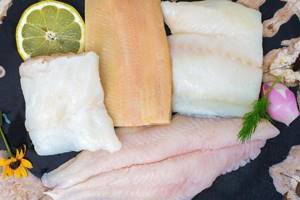
Useful properties of the product
Haddock is tasty and nutritious , and has virtually no characteristic fishy taste or smell. With a low calorie content, fish has virtually no carbohydrates and very little fat. Nutritional value per 100 grams of boiled fish is 72.3 kcal . Ratio of BZHU (proteins, fats, carbohydrates): 17.2 g / 0.6 g / 0. Fish contains many substances beneficial to the body.
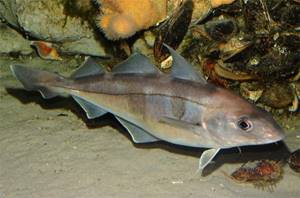
Fish contains a bouquet of micro and macroelements, vitamins and minerals, omega-3 and omega-6 fatty acids. The low calorie level will prevent you from gaining excess weight when consumed. Fish is well absorbed by the body due to the absence of protein (elastin). Due to its low fat content, haddock meat is suitable for weight loss diets. The bulk of the fat is contained in the liver of cod fish; under industrial conditions, the fat is rendered. Fish oil is used in medicine. Cod liver (including haddock) is a valuable food product.
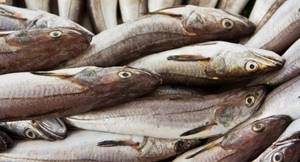
- Protein metabolism is activated and the immune system is strengthened.
- Replenishing iodine deficiency in the body.
- Brain function improves.
- Promotes the formation of red blood cells and DNA.
- The functioning of the digestive, cardiovascular system, and lungs improves.
- Promotes healthy bone and joint formation.
- Controlling cholesterol levels in the body.
- The aging process slows down.
- Improvement in vision is observed.
- Rejuvenating effect.
With regular consumption of haddock meat, there will be no need to introduce medicinal fish oil into the body. Before introducing fish into a child’s diet, it is recommended to consult a pediatrician. For older people, consuming this seafood product will help strengthen joints and partially relieve pain from arthrosis and arthritis.

For all
Many people complain that stewed haddock does not have a strong taste. The calorie content of the fish remains within the limits acceptable for any menu, but I would like to make the taste more vibrant and original. How to cook stewed haddock in sauce? It’s very simple, and it’s light in calories – 88 kilocalories per 100 grams. The washed fillet should be cut and placed in a frying pan with a drop of oil. Simmer over low heat until done. A quarter of an hour is enough. At the same time, you can prepare the sauce - mix milk with low-fat sour cream, a teaspoon of flour and salt. Stirring until the sauce thickens. Now you need to pour it over the fish and simmer for another 3-4 minutes. This fish is perfectly digestible and improves digestion.
How to use when losing weight
The low calorie content and high protein content of haddock allows it to be included in the diet of people watching their weight and on a diet. Fish has the ability to dissolve excess cholesterol in the blood and strengthen the cardiovascular system.
Haddock should not be consumed as a mono-diet, because it does not contain the entire spectrum of necessary substances. It is necessary to combine fish with other dietary products for a balanced diet.
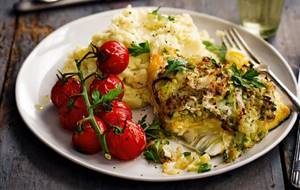
KBJU per 100 g depending on the method of preparation of the product:
| Method of cooking fish | Kilocalories | Squirrels | Fats | Carbohydrates |
| For a couple | 71.9 kcal | 17.2 g | 0.5 g | 0 g |
| Boiled | 72.3 kcal | 17.2 g | 0.6 g | 0 g |
| Stewed | 65.2 kcal | 14.9 g | 0.4 g | 0.5 g |
| Baked in the oven | 87 kcal | 67.4 g | 5 g | 0 g |
| Fried | 121.1 kcal | 16.6 g | 4.5 g | 3.5 g |
| Cutlets | 115.8 kcal | 14.5 g | 3.8 g | 5.8 g |
Haddock is suitable for preparing any fish dishes. Due to the absence of small bones, it makes excellent cutlets or aspic. It is recommended to prepare dishes without using oil and with a minimum amount of salt, and opt for vegetables as a side dish.
For diet
If a person adheres to the principles of proper nutrition, then the calorie content of boiled haddock will be of particular interest to him. Fish has only 69 to 73 kilocalories per 100 grams, depending on how you cook it and what you add to the fish during the process. The result is juicy white meat with a subdued, mild flavor. Haddock perfectly absorbs other flavors and complements them. Therefore, cooking methods can be completely different, as well as serving. Fish is served with sauces, seasonings, vegetables, fruits and even cream. Its thin skin becomes crispy and tasty when fried. You don't even need to clean it off. And the haddock becomes most tender during steaming.
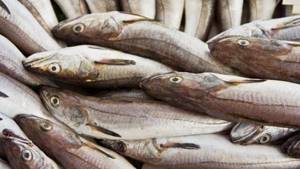
Delicious recipes
Baked Haddock
- Haddock fillet.
- Onion – 1 pc.
- Juice of a lemon wedge.
- Salt and pepper to taste.
- Olive oil.
- Clean the fish fillet and cut into portions.
- Cut the onion into half rings.
- Grease the foil with olive oil, add the prepared fish, season with spices and lemon juice, add onion and wrap.
- Bake at 200 degrees for 25-30 minutes.
- Serve with fresh or roasted vegetables.
Haddock salad with pineapple
- Fish – 1 carcass.
- Onion – 1 pc.
- Rice – 100 g.
- Rice vinegar – 1 teaspoon.
- Eggs – 3 pcs.
- Canned pineapple – 1 can (400 g).
- Boil the fish for 25 minutes.
- Finely chop the onion and pour boiling water over it to remove the bitterness.
- Boil rice, mix with rice vinegar.
- Finely chop the eggs.
- Cut the pineapple into cubes.
- Mix all the salad ingredients, add salt to taste, you can add red pepper, garnish the salad with dill sprigs and red caviar.
The unusual combination of fish and pineapple gives a pleasant taste sensation. Haddock is a universal product for preparing salads, pates, cutlets, first and second courses.
Fish cutlets
- Haddock – 1 kg.
- Boiled rice (round grain) – 200 g.
- White loaf – 2 pieces.
- Onions – 2 pcs.
- Green onions (finely chopped) – 4 tablespoons.
- Cream (10%) – 2 cups.
- Breadcrumbs – 1 package.
- Vegetable oil for frying cutlets.
- Salt and pepper to taste.
- Separate the fish from the bones and skin, grind in a meat grinder with onions and a loaf soaked in cream.
- Add boiled rice, green onions and spices to the minced meat, knead the minced meat.
- Make cutlets, roll in breadcrumbs and fry in a frying pan on both sides until golden brown.
Haddock is loved by the peoples of England; in Finland they prepare dumplings with it. In Norway and Iceland they prefer dried fish.
The most tender fish
For the holiday table, you can prepare dietary haddock stewed in cream with potatoes. There is almost no fat in this dish, except that contained in the cream. If you want to reduce calorie content to a minimum, then it is better to take low-fat cream or milk. Boil the potatoes in their skins and remove the skins. Cut into cubes or small slices. Cut the fish fillet too. Meanwhile, bring the cream to a boil in a small saucepan and add the fish. Add spices to taste. You don’t need to cook for long, only 5-7 minutes, and then add the potatoes and simmer the dish over low heat, covering with a lid. For taste, you can add onions, chopped herbs and a piece of butter.
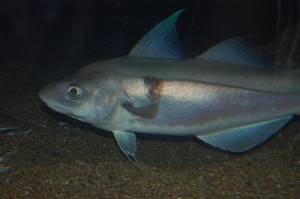
Taste qualities
The white, lean meat of haddock has a dense, elastic consistency and a pleasant taste with a characteristic iodine aftertaste. Haddock tolerates cooking well and is suitable for many cooking methods. The culinary value of fish is also enhanced by the fact that it contains practically no small bones or hard fibers. However, prolonged thermal exposure can affect the appearance of the dish and the taste of the fish. The haddock begins to separate and the meat loses its juiciness and flavor. When choosing fish, you should pay attention to its freshness. Freezing, especially accompanied by periodic thawing, dries out haddock, and this primarily applies to fillets and semi-finished products from this fish worthy of gourmet attention. Haddock liver is less rich in fat than cod liver, but the taste and aroma are very similar to this product and can be used both in dietary nutrition and in the preparation of gourmet dishes.


